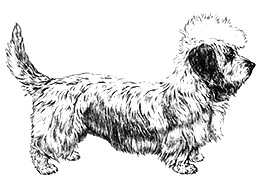Breed standards
Dandie Dinmont Terrier
Breed standards are the official guidelines that describe the ideal characteristics, temperament, and appearance of a breed and ensures that the breed is fit for function with soundness essential.

Kennel Club, London 1994
KC Amended May 1998
Amended Australia January 2000
FCI Standard No 168
Distinctive head with beautiful silky covering, with large, wise intelligent eyes offsetting long, low weasley body. Short, strong legs; weatherproof coat.
Game, workmanlike Terrier.
Independent, highly intelligent, determined, persistent, sensitive, affectionate and dignified.
Head strongly made, large but in proportion to dog's size, muscles showing extraordinary development, especially the maxillary. Skull broad, narrowing towards eye, measuring about same from inner corner of eye to back of skull, as from ear to ear. Forehead well domed; head covered with very soft, silky hair not confined to mere topknot. Cheeks gradually tapering towards deep and strongly made muzzle. Muzzle in proportion to skull as three is to five. Top of muzzle has triangular bare patch pointing backwards to eyes from nose about an inch broad. Nose black.
Rich dark hazel; set wide apart and low, large for a small dog, bright, full and round but not protruding.
Pendulous, set well back, wide apart, low on skull, hanging close to cheeks with very slight projection at base; broad at junction of head and tapering almost to a point, fore part of ear coming almost straight down from its junction with head to tip. Cartilage and skin of ear very thin. Length of ear, from 7.5 - 10 cms (3 - 4 ins). Ears harmonise in colour with body colour. In a pepper dog covered with soft, straight, dark hair (in some cases almost black). In a mustard dog, hair mustard in colour, a shade darker than body but not black. Both should have a thin feather of light hair starting about 5 cms (2 ins.) from the tip, and of nearly the same colour and texture as topknot, giving ear appearance of a distinct point. This may not appear until after the age of two years.
Jaws strong with a perfect, regular and complete scissor bite, i.e. upper teeth closely overlapping the lower teeth and set square to the jaws. Any deviation highly undesirable. Teeth very strong especially canines which are extraordinary in size for a small dog. Canines fit well against each other, to give greatest available holding and punishing powers. Inside of mouth black or dark coloured.
Very muscular, well developed and strong, showing great power. Well set into shoulders.
Shoulders well laid back but not heavy. Forelegs short with immense muscular development and bone, set wide apart and chest coming well down between them. Forearms to follow line of chest with feet pointing forward or slightly outward when standing. Bandy legs highly undesirable.
Long, strong and flexible; ribs well sprung and round, chest well developed and well let down between forelegs; back rather low at shoulders having slight downward curve and corresponding arch over loins, slight gradual drop from top of loin to root of tail. Backbone well muscled.
Hindlegs a little longer than forelegs; set rather wide apart, but not spread out in an unnatural manner; thighs well developed. Stifles angulated, hocks well let down. Dew claws, if present, customarily removed.
Round and well padded. Hind feet smaller than forefeet. Nails dark but varying in shade according to colour of body. Flat or open feet highly undesirable.
Rather short from 20 - 25 cms (8 - 10 ins), rather thick at root, getting thicker for about 10 cms (4 ins) and tapering off to a point. Not twisted or curled in any way but with a curve like a scimitar, the tip when excited being in a perpendicular line with root of tail, set neither too high nor too low. When not excited carried gaily a little above body level.
Strong, straight impulsion from rear, giving a fluent free and easy stride, reaching forward at the front. A stiff, stilted, hopping or weaving gait highly undesirable.
Very important feature of the breed. Hair should be about 5cms (2 ins) long.Double coat with a soft linty undercoat and a harder topcoat, not wiry but giving crisp feel to the hand. The coat should not 'shed' down the back, but should lie in pencils caused by the harder hair coming through the softer undercoat. The forelegs have feather about 5 cms (2 ins) long. Upper side of tail covered with wiry hair, under-side not so wiry with neat feathering of softer hair.
Pepper or mustard.
PEPPER - Ranges from dark bluish black to light silvery grey, intermediate shades preferred. Body colour coming well down shoulder and hips gradually emerging into colour of legs and feet which varies according to body colour from rich tan to pale fawn. Profuse silvery white topknot.
MUSTARD - Varies from reddish brown to pale fawn. Profuse creamy white topknot, legs and feet of darker shade than head. In both colours feather on forelegs rather lighter than hair on fore part of leg. Some white hair on chest and white nails permissible. White feet undesirable. Hair on under-side of tail lighter than on upperside which should be darker colour than body.
The height at withers should be from 20-28cms (8-11 ins), length from withers to root of tail should not be more than twice the height, but preferably 2.5-5cm (1" to 2") less.
Any departure from the foregoing points should be considered a fault and the seriousness with which the fault should be regarded should be in exact proportion to its degree and its effect upon the health and welfare of the dog.
Male animals should have two apparently normal testicles fully descended into the scrotum.



